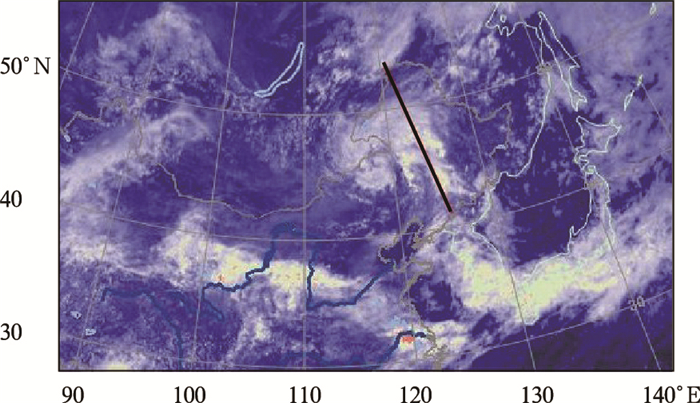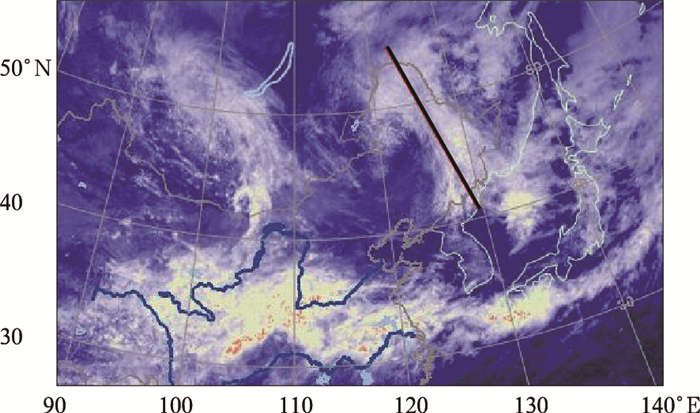Vertical Structure of Convective Cloud in a Cold Vortex over Northeastern China Using CloudSat Data
-
摘要: 利用CloudSat卫星资料、NCEP再分析资料和FY-2C卫星可见光云图分析了2006年7月20—24日我国东北一次冷涡过程不同时期对流云的垂直结构以及云内中小尺度的结构,发现在冷涡发展阶段的初期,暖锋对流结构表现为孤立的回波系统多,强对流深厚,对流系统体现为孤立、深厚的特征。在冷涡发展成熟阶段,回波强度比冷涡发展初期的对流系统有所减弱,且为浅薄的对流系统。冷涡系统影响下发展的锢囚锋回波系统顶部呈现独特的结构特征:东南部为干冷空气侵入造成的回波区, 中部为锢囚锋主体对流区, 西北部为暖锋遇冷锋抬升作用形成的回波区。在锢囚锋尾部存在冰水含量与液态水含量分层现象,干冷空气侵入层在5 km高度左右,在干冷空气侵入层上部为冰水含量分布的弱回波区,下部为液态水分布的弱回波区。在冷涡成熟阶段,对流系统分布在冷涡外沿,表现为孤立的对流系统,冰水含量多的对流系统主要在冷涡的北面,而液态水主要分布在冷涡中心零度层以下。Abstract: Cold vortex (or cold low, also called cut-off low), characterized by a cold core and low pressure center over 500 hPa level, is one of the most frequent weather systems over Northeast China. It is often accompanied by strong convective incident, and can bring a wide range of continuous rainfall. However, most of the past researches mainly focus on the environmental conditions and large scale of the cold vortex systems. There is little analysis on meso-scale structure of the convective systems of cold vortex, especially using satellite and radar data, and the understanding on the vertical structure of the meso-scale convective systems is limited. CloudSat data, NCEP reanalysis data and visible light satellite data has been used to analyze the convective rain bands and meso-scale cloud structure of different stages of a cold vortex over Northeast China during 20—24 July 2006.The results show that at the beginning of development stage, the structure of the warm front is characterized with isolated and deep convective systems. At the development and matured stage, the intensity of radar echo is weaker than its development stage, and the convective systems are shallow. The echo top of occlusion under the cold vortex system presents some special characteristics: In the southeast of occlusion, the echo area is driven by the cold-dry air; in the middle area of occlusion is the main convective system and in the northwest area echo is caused by the lifting effect of warm front confront the cold front. There is delamination between ice water and liquid water at the tail of the occlusion front. The height of incursion layer of dry-cold air is about 5 km, above which is the weak echo consisting of ice water, and below the incursion layer is the echo with liquid water. At the mature stage of the cold vortex, the convective systems are located mainly outside the cold vortex in the form of isolated convective systems. Convective systems which contains plenty of ice water content are mainly located in the north of the cold vortex, while liquid water content exists below the 0℃ layer of the cold vortex center.
-
Keywords:
- CloudSat /
- cold vortex /
- occlusion /
- cold-dry air
-
引言
水汽在大气物理过程中扮演着极其重要的角色, 对大气水汽总量及其演变的测量, 有助于对风暴系统的结构和演变、地气系统的能量平衡等问题的研究。运用GPS技术估算大气水汽总量是20世纪90年代发展起来的一种有潜力有实用价值的新方法。1992年Bevis等人提出了采用地基GPS估算大气水汽含量的原理, 1993年美国进行了GPS/S TORM观测试验, 并采用“相对GPS”方案 (在参考站引入微波辐射计WVR消除差分误差) 对数据进行了处理, 稍后, 在对GPS/S TORM试验获取的资料进行处理的过程中, Duan[1]和Bevis[2]又提出了反演大气水汽总量的“纯GPS”方案 (无需WVR定标)。在国内, 近几年也开始了这方面的研究工作[3~6]。特别是, 在1998年5、6月的“海峡两岸及邻近地区暴雨试验”期间, 我们进行了组建地基GPS接收站进行实际探测的试验, 以期获得有关大气水汽总量的信息。试验是成功的, 初步结果显示出地基GPS反演水汽总量是一种有前途的遥感技术。
1. 外场试验与GPS资料的处理
在1998年的“海峡两岸及邻近地区暴雨试验”期间, 于汕头、阳江两地分别建立了GPS临时接收站, 汕头的GPS接收机建在地面气象观测场内, 阳江GPS站位于距地面气象观测场约2 m处。从5月5日起至6月26日试验结束, 上述两站的GPS接收机进行了连续观测。同期, 海口地震观测系统的GPS接收站也参加试验进行了连续观测。表 1给出试验所用GPS接收机性能参数及站点的地理数据。
表 1 GPS站点地理数据及所用GPS接收机性能参数简表
试验期间汕头、阳江、海口3站获得的GPS原始数据, 采用了GAMIT软件进行处理, 处理中参与联合运算的有:海口、上海、天津、TSKB (日本)、IRK T (俄罗斯)、Kitab (乌兹别克) 等9个GPS测站的资料。处理得到了间隔为每0.5 h一次的总延迟量。由于接收机采用的是双频接收机, 电离层延迟已在处理过程中被对消掉, 总延迟量为中性大气延迟量。
2. 大气水汽总量的估算方法
各站GPS数据处理得到的基本量是中性大气延迟量, 它应由干延迟和湿延迟两部分组成。干延迟量可根据测站的地面气压及地理坐标计算出来, 本文采用了Elgered等人[7]的公式:

(1) 式中:P0为测站地面气压, λ为地理纬度, H为测站海拔高度, f (λ, H)=(1-0.00266cos (2λ)-0.00028H), 湿延迟量由实测的总延迟量减去干延迟量求得。
大气水汽总量Wp(Precipi table Water) 定义为:垂直方向气柱内的水汽全部折算成液态水的高度。它与湿延迟量 (d) 之间存在一定的关系。Businger等人[8]给出的经验关系为:

(2) 其中, ρw是水汽密度, Rv是水汽的气体常数, Tm是加权平均温度[9]

(3) 

(4) Pd是干空气压强, Pv是水汽压。Π是与气象参数有关的系数, Π通常可用一定常系数0.156来近似, 为简化处理, 本文采用Π=0.156进行计算。
3. 试验初步结果与讨论
我们对试验期间上述3站获得的GPS连续观测资料进行了处理, 通过上述的处理, 估算出间隔为0.5 h一次的大气水汽总量, 与当地探空资料计算出的大气水汽总量进行了比较。图 1给出的是试验期间汕头站探空与GPS反演的水汽总量的对比结果, 以及地面逐时降水资料。横坐标为观测时间, 主纵坐标为水汽总量 (单位:mm), 次纵坐标为降水量 (单位:mm/h)。图中, 连续曲线为GPS反演的水汽总量、圆点为探空资料计算出的大气水汽总量、柱形条为降水量。
从图 1中可以看出, GPS反演的水汽总量与探空计算的结果相比变化趋势一致, 图 2给出两者偏差 (探空与GPS值之差) 的概率分布曲线 (样本数为205), GPS反演的水汽总量比探空计算的结果平均偏低6.5 mm, 偏差的均方差为4.3 mm。
GPS连续观测的特点, 使GPS反演的水汽总量具有很高的时间精度, 从时间上近乎连续的水汽总量演变图中, 我们可以看出, 大气水汽总量存在不同尺度的周期性变化。图 1中, 振幅变化较大, 平均振幅为33 mm的波动的周期为7.2天。
GPS反演的水汽总量较好地反应出水汽积累和释放过程, 水汽总量大致是以迅速增加、相对稳定、迅速降低的规律呈周期变化, 而这一点在探空资料上的反应不明确。
由图 1还可以看出, 水汽总量随时间变化的总趋势是逐渐增加的, 这可能和大气湿度随季节的变化有关, 5月份湿度较小、6月份湿度较大。表 2给出5、6月份水汽总量统计值, 可以看出, 水汽总量随季节有比较明显的变化, 5、6两月水汽总量平均值相差6.9 mm, 对应湿延迟的变化约4cm左右。
表 2 汕头1998年5~6月水汽总量统计 (mm)
另外, 我们将GPS反演的水汽总量与地面实测的逐时累积降水量资料进行了比较, 如图 1。从图上可以看出, GPS反演水汽总量变化周期和地面降水发生的周期基本相同。地面降水大多发生在GPS反演水汽总量处于相对高值且变化率较大的时候。
4. 结束语
本文对“海峡两岸及邻近地区暴雨试验”中获取的GPS与气象资料进行了反演水汽总量的对比分析。结果表明:GPS反演的大气水汽总量与探空计算的大气水汽总量, 两者随时间演变的趋势一致; GPS反演的水汽总量随时间明显的呈周期性变化, 能较好地反应出与天气过程相伴随的水汽积累和释放过程。GPS反演的水汽总量与地面实测的逐小时累积降水量资料进行的比较表明, 两者存在较好的对应关系, 地面降水大多发生在GPS反演的水汽总量处于相对高值且变化率较大的时候。
本文仅对“海峡两岸及邻近地区暴雨试验”中获取的GPS资料进行了常规的处理和初步的对比分析, 我们将对此作进一步的分析研究。初步的对比分析结果表明, 地基GPS技术用于大气水汽总量的观测具有很多突出优点, 是一项很有潜力的探测技术。
致谢: 感谢北京应用气象研究所许焕斌研究员为本文提出的修改建议。 -
图 1 2006年7月20日06:00位势高度场 (实线,单位:gpm)、位温场 (灰色) 及水平风场 (矢量)
(长虚线为CloudSat轨道1206 03:50扫过的轨迹) (a) 500 hPa,(b) 950 hPa
Figure 1. 500 hPa (a) and 950 hPa (b) geopotential height (solid line, unit: gpm), potential temperature (grey) and wind (vector) fields at 06:00 20 July 2006
(the long dashed line represents CloudSat section of granule 1206 at 03:50 20 July 2006)
图 3 2006年7月20日04:53 CloudSat轨道1206扫过轨迹 (a) 雷达反射率因子 (灰色) 和假相当位温 (等值线,单位:K) 剖面,(b) 冰水含量 (灰色) 和液态水含量 (黑色区域,不低于100 mg·m-3) 与温度 (等值线,单位:℃) 剖面
Figure 3. CloudSat of granule 1206 cloud profiling at 04:53 20 July 2006 (a) radar reflectivity (grey) and equivalent potential temperature (contour, unit: K), (b) ice water content (grey), liquid water content (black area, no less than 100 mg·m-3) and temperature (contour, unit:℃)
表 1 CloudSat卫星数据产品代码及相应产品名称
Table 1 CloudSat data code and its relevant product
产品编码 产品名称 1B-CPR, 1B-CPR-FL 雷达散射剖面 2B-GEOPROF 云的几何剖面 2B-CLDCLASS 云的分类 2B-CWC-RO 组合 (液态、固态) 水含量 (单雷达) 2B-CWC-RVOD 组合水含量和可见光光学厚度 2B-TAU 云光学厚度 2B-FLXHR 通量和加热率 2B-CLDCLASS-LIDAR 激光雷达云几何剖面 -
陶诗言.中国之暴雨.北京:科学出版社, 1980:1-225. 赵思雄, 刘苏红, 刘名扬.夏季北京冷涡强对流天气的中尺度分析.中国科学院大气物理所集刊 (第9号), 北京:科学出版社, 1980. 王东海, 钟水新, 刘英, 等.东北暴雨的研究.地球科学进展, 2007, 22(6): 549-560. http://www.cnki.com.cn/Article/CJFDTOTAL-DXJZ200706001.htm 陈力强, 陈受钧, 周小珊, 等.东北冷涡诱发的一次MCS结构特征数值模拟.气象学报, 2005, 63(2):173-183. DOI: 10.11676/qxxb2005.017 乔枫雪, 赵思雄, 孙建华.一次引发暴雨的东北低涡的涡度和水汽收支分析.气候与环境研究, 2007, 12(3): 397-411. http://www.cnki.com.cn/Article/CJFDTOTAL-QHYH200703020.htm 孙力, 郑秀雅, 王琪.东北冷涡的时空分布特征及其与东亚大型环流系统之间的关系.应用气象学报, 1994, 5(3):297-303. http://qikan.camscma.cn/jams/ch/reader/view_abstract.aspx?file_no=19940353&flag=1 陈文选, 王俊, 刘文.一次冷涡过程降水的微物理机制分析.应用气象学报, 1999, 10(2):190-198. http://qikan.camscma.cn/jams/ch/reader/view_abstract.aspx?file_no=19990258&flag=1 姜学恭, 孙永刚, 沈建国. 98.8松嫩流域一次东北冷涡暴雨的数值模拟初步分析.应用气象学报, 2001, 12(2):176-187. http://qikan.camscma.cn/jams/ch/reader/view_abstract.aspx?file_no=20010224&flag=1 章国材, 李晓莉, 乔林.夏季500 hPa副热带高压区域一次暴雨过程环流条件的诊断分析.应用气象学报, 2005, 16(3):396-401. http://qikan.camscma.cn/jams/ch/reader/view_abstract.aspx?file_no=20050348&flag=1 Kei Sakamoto. Cut off and weakening processes of an upper cold low. Journal of the Meteorological Society of Japan, 2005, 83: 817-834. DOI: 10.2151/jmsj.83.817
齐彦斌, 郭学良, 金德镇.一次东北冷涡中对流云带的宏微物理结构探测研究.大气科学, 2007, 31(4): 621-634. http://www.cnki.com.cn/Article/CJFDTOTAL-DQXK200704006.htm 刘健, 张文建, 朱元竞, 等.中尺度强暴雨云团云特征的多种卫星资料综合分析.应用气象学报, 2007, 18(2): 158-164. http://qikan.camscma.cn/jams/ch/reader/view_abstract.aspx?file_no=20070228&flag=1 方宗义, 覃丹宇.暴雨云团的卫星监测和研究进展.应用气象学报, 2006, 17(5):584-593. http://qikan.camscma.cn/jams/ch/reader/view_abstract.aspx?file_no=200605100&flag=1 Stephens G L, Coauthors. The CloudSat mission and the A-train. Bull Amer Meteor Soc, 2002, 83: 1771-1790. DOI: 10.1175/BAMS-83-12-1771
Richard Austin. Level 2 Cloud Ice Water Content Product Process Description and Interface Control Document. Colorado: Colorado State University, 2004:1-29. 钟水新. 一次东北冷涡暴雨过程的诊断分析与数值模拟研究. 北京: 中国气象科学研究院, 2008. 郑秀雅, 张延治, 白人海.东北暴雨.北京:气象出版社, 1992: 129-130. Simmons A J, Hoskins B J. The downstream and upstream development of unstable baroclinic waves. J Atmos Sci, 1979, 36: 1239-1254. DOI: 10.1175/1520-0469(1979)036<1239:TDAUDO>2.0.CO;2
Thorncroft C D, Hoskins B J. Frontal cyclogenesis. J Atmos Sci, 1990, 47: 2317-2336. DOI: 10.1175/1520-0469(1990)047<2317:FC>2.0.CO;2
Orlanski I, Chang E K M. Ageostrophic geopotential fluxes in downstream and upstream development of baroclinic waves. J Atmos Sci, 1993, 50: 212-225. DOI: 10.1175/1520-0469(1993)050<0212:AGFIDA>2.0.CO;2
Decker S G, Martin J E. A local energetic analysis of the life cycle differences between consecutive, explosively deepening, continental cyclones. Mon Wea Rev, 2005, 133: 295-316. DOI: 10.1175/MWR-2860.1
Mailier P J, Stephenson D B, Ferro C A T, et al. Serial clustering of extratropical cyclones. Mon Wea Rev, 2006, 134: 2224-2240. DOI: 10.1175/MWR3160.1
Derek J P, Graeme L S, Martin M. CLOUDSAT: Adding a new dimension to a classical view of extratropical cyclones. Bull Amer Meteor Soc, 2008, 89(5): 599-609. DOI: 10.1175/BAMS-89-5-599
Shapiro M A, Keyser D. Fronts, Jet Streams, and the Tropopause. Amer Meteor Soc, 1990: 167-191. DOI: 10.1175/BAMS-89-5-599
Posselt D J, Martin J E. The role of latent heat release in the formation of a warm occluded thermal structure. Mon Wea Rev, 2004, 132: 578-599. DOI: 10.1175/1520-0493(2004)132<0578:TEOLHR>2.0.CO;2

 设为首页
设为首页 加入收藏
加入收藏


 下载:
下载:










